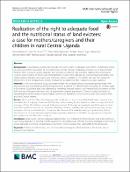| dc.description.abstract | In developing countries like Uganda, the human right to adequate food (RtAF) is inextricably linked
to access to land for households to feed themselves directly through production or means for its procurement.
Whether RtAF is enjoyed among Ugandan land evictees, is unknown. We therefore explored this among land
evictees (rights-holders) in Wakiso and Mpigi districts in rural Central Uganda. We assessed food accessibility and
related coping strategies, diet quality and nutritional status of children 6–59 months old, and their caregivers.
Effectiveness of the complaint and redress mechanisms in addressing RtAF violations was also explored.
Methods: In this cross-sectional study, quantitative data was collected using a structured questionnaire, with
food security and nutritional assessment methods from a total of 215 land evictees including 187 children aged
6–59 months. Qualitative data was collected by reviewing selected national and international documents on the
RtAF and key informant interviews with 15 purposively sampled duty-bearers. These included individuals or
representatives of the Uganda Human Rights Commission, Resident District Commissioner, Sub-county Chiefs,
and local Council leaders.
Results: We found that 78% of land evictees had insufficient access to food while 69.4% had consumed a less
diversified diet. A majority of evictees (85.2%) relied on borrowing food or help from others to cope with food
shortages. Of the 187 children assessed, 9.6% were wasted, 18.2% were underweight and 34.2% were stunted.
Small, but significant associations, were found between food accessibility, diet quality, food insecurity coping
strategies; and the nutritional status of evictees. We observed that administrative, quasi-judicial and judicial
mechanisms to provide adequate legal remedies regarding violations of the RtAF among evictees in Uganda
are in place, but not effective in doing so.
Conclusion: Land eviction without adequate legal remedies is a contributor to food insecurity and undernutrition in
rural Central Uganda. It is essential that the Government strengthens and enforces the policy and legal environment to
ensure adequate and timely compensation of evictees in order to reduce their vulnerability to food insecurity. | en_US |

